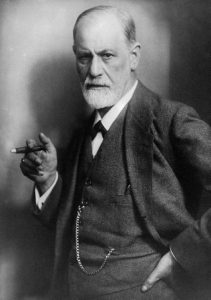Perspectives of Psychology
Introduction
In this section, we will review the history of psychology with a focus on the important questions that psychologists ask and the major approaches (or schools) of psychological inquiry. We will explore the various approaches to psychology and their important contributors, such as Sigmund Freud, John Watson, and Charles Darwin. In addition, we will provide an overview of psychodynamic psychology, behaviorism, social cultural and cognitive perspectives and more.
The approaches that psychologists have used to assess the issues that interest them have changed dramatically over the history of psychology. Perhaps most importantly, the field has moved steadily from speculation about behavior toward a more objective and scientific approach as the technology available to study human behavior has improved (Benjamin & Baker, 2004). There has also been an increasing influx of women into the field. Although most early psychologists were men, now most psychologists, including the presidents of the most important psychological organizations, are women. Some important female psychologists include Anna Freud, Karen Horney and Mary Ainsworth.

Although psychology has changed dramatically over its history, the most important questions that psychologists address have remained constant. Some of these questions follow, and we will discuss them both in this section and in the sections to come.
Stangor, C. (2017). Introduction to psychology. Boston, MA: Flatworld
Benjamin, L. T., Jr., & Baker, D. B. (2004). From seance to science: A history of the profession of psychology in America. Belmont, CA: Wadsworth/Thomson
Stangor, C. (2017). Introduction to psychology. Boston, MA: Flatworld
Approaches to Psychology
Psychodynamic Psychology
Perhaps the school of psychology that is most familiar to the general public is the psychodynamic approach to understanding behavior, which was championed by Sigmund Freud (1856–1939) and his followers. Psychodynamic psychology is an approach to understanding human behavior that focuses on the role of unconscious thoughts, feelings, and memories. Freud developed his theories about behavior through extensive analysis of the patients that he treated in his private clinical practice. Freud believed that many of the problems that his patients experienced, including anxiety, depression, and sexual dysfunction, were the result of the effects of painful childhood experiences that the person could no longer remember.

“Sigmund Freud.” Retrieved from https://pixabay.com/en/sigmund-freud-doctor-neurologist-400399/. Licensed under CCO.
Freud’s ideas were extended by other psychologists whom he influenced, including Carl Jung (1875–1961), Alfred Adler (1870–1937), Karen Horney (1855–1952), and Erik Erikson (1902–1994). These, and others who follow the psychodynamic approach, believe that it is possible to help the patient if the unconscious drives can be remembered, particularly through a deep and thorough exploration of the person’s early sexual experiences and current sexual desires. These explorations are revealed through talk therapy and dream analysis, in a process called psychoanalysis.
The founders of the school of psychodynamics were primarily practitioners who worked with individuals to help them understand and confront their psychological symptoms. Although they did not conduct much research on their ideas, and although later, more sophisticated tests of their theories have not always supported their proposals, psychodynamics has nevertheless had substantial impact on the field of psychology, and indeed on thinking about human behavior more generally (Moore & Fine, 1995). The importance of the unconscious in human behavior, the idea that early childhood experiences are critical, and the concept of therapy as a way of improving human lives, are all ideas that are derived from the psychodynamic approach and that remain central to psychology.
Moore, B. E., & Fine, B. D. (1995). Psychoanalysis: The major concepts. New Haven, CT: Yale University Press.
Stangor, C. (2017). Introduction to psychology. Boston, MA: Flatworld
Behaviorism and the Question of Free Will
Although they differed in approach, both structuralism and functionalism were essentially studies of the mind. The psychologists associated with the school of behaviorism, on the other hand, were reacting in part to the difficulties psychologists encountered when they tried to use introspection to understand behavior. Behaviorism is a school of psychology that is based on the premise that it is not possible to objectively study the mind, and therefore, psychologists should limit their attention to the study of behavior itself. Behaviorists believe that the human mind is a “black box” into which stimuli are sent and from which responses are received. They argue that there is no point in trying to determine what happens in the box because we can successfully predict behavior without knowing what happens inside the mind. Furthermore, behaviorists believe that it is possible to develop laws of learning that can explain all behaviors.
The first behaviorist was the American psychologist John B. Watson (1878–1958). Watson was influenced in large part by the work of the Russian physiologist Ivan Pavlov (1849–1936), who had discovered that dogs would salivate at the sound of a tone that had previously been associated with the presentation of food. Watson and the other behaviorists began to use these ideas to explain how events that people and other organisms experienced in their environment (stimuli) could produce specific behaviors (responses). For instance, in Pavlov’s research the stimulus (either the food or, after learning, the tone) would produce the response of salivation in the dogs.
In his research, Watson found that systematically exposing a child to fearful stimuli in the presence of objects that did not themselves elicit fear could lead the child to respond with a fearful behavior to the presence of the stimulus (Watson & Rayner, 1920; Beck, Levinson, & Irons, 2009). In the best known of his studies, an 8-month-old boy named Little Albert was used as the subject. Here is a summary of the findings:
The boy was placed in the middle of a room; a white laboratory rat was placed near him and he was allowed to play with it. The child showed no fear of the rat. In later trials, the researchers made a loud sound behind Albert’s back by striking a steel bar with a hammer whenever the baby touched the rat. The child cried when he heard the noise. After several such pairings of the two stimuli, the child was again shown the rat. Now, however, he cried and tried to move away from the rat.
In line with the behaviorist approach, the boy had learned to associate the white rat with the loud noise, resulting in crying.
The most famous behaviorist was Burrhus Frederick (B. F.) Skinner (1904–1990), who expanded the principles of behaviorism and also brought them to the attention of the public at large. Skinner used the ideas of stimulus and response, along with the application of rewards or reinforcements, to train pigeons and other animals. He used the general principles of behaviorism to develop theories about how best to teach children and how to create societies that were peaceful and productive. Skinner even developed a method for studying thoughts and feelings using the behaviorist approach (Skinner, 1957, 1968, 1972).

“B.F. Skinner.” Retrieved from https://www.flickr.com/photos/psychpics/4544260178. Licensed under CC-BY-NC-ND 2.0.
The behaviorists made substantial contributions to psychology by identifying the principles of learning. Although the behaviorists were incorrect in their beliefs that it was not possible to measure thoughts and feelings, their ideas provided new ideas that helped further our understanding regarding the nature-nurture debate as well as the question of free will. The ideas of behaviorism are fundamental to psychology and have been developed to help us better understand the role of prior experiences in a variety of areas of psychology.
Skinner, B. (1957). Verbal behavior. Acton, MA: Copley; Skinner, B. (1968). The technology of teaching. New York, NY: Appleton-Century-Crofts; Skinner, B. (1972). Beyond freedom and dignity. New York, NY: Vintage Books.
Stangor, C. (2017). Introduction to psychology. Boston, MA: Flatworld.
Watson, J. B., & Rayner, R. (1920). Conditioned emotional reactions. Journal of Experimental Psychology, 3(1), 1–14; Beck, H. P., Levinson, S., & Irons, G. (2009). Finding Little Albert: A journey to John B. Watson’s infant laboratory. American Psychologist, 64(7), 605–614.
The Cognitive Approach and Cognitive Neuroscience
Science is always influenced by the technology that surrounds it, and psychology is no exception. Thus it is no surprise that beginning in the 1960s, growing numbers of psychologists began to think about the brain and about human behavior in terms of the computer, which was being developed and becoming publicly available at that time. Psychologists noted that when people processed information about the world around them, they acted much like computers do. Information was first input into the system through the eyes, ears, and other perceptual senses. The brain then acted like a central processing unit, combining and analyzing the data that it had received. Some of this information was placed in long-term memory storage in the brain for later use. Then the system returned an output, such as a behavior. The analogy between the brain and the computer, although by no means perfect, provided part of the impetus for a new school of psychology called cognitive psychology (Sternberg & Sternberg, 2016). Cognitive psychology is a field of psychology that studies mental processes, including perception, thinking, memory, and judgment. These actions correspond well to the processes that computers perform.
Although cognitive psychology began in earnest in the 1960s, earlier psychologists had also taken a cognitive orientation. Some of the important contributors to cognitive psychology include the German psychologist Hermann Ebbinghaus (1850–1909), who studied the ability of people to remember lists of words under different conditions, and the English psychologist Sir Frederic Bartlett (1886–1969), who studied the cognitive and social processes of remembering. Bartlett created short stories that were in some ways logical but also contained some very unusual and unexpected events. Bartlett discovered that people found it very difficult to recall the stories exactly, even after being allowed to study them repeatedly, and he hypothesized that the stories were difficult to remember because they did not fit the participants’ expectations about how stories should go. The idea that our memory is influenced by what we already know was also a major idea behind the cognitive-developmental stage model of Swiss psychologist Jean Piaget (1896–1980). Other important cognitive psychologists include Donald E. Broadbent (1926–1993), Daniel Kahneman (1934–), George Miller (1920–), Eleanor Rosch (1938–), and Amos Tversky (1937–1996).

Piaget photo courtesy of David Kauppi, http://www.flickr.com/photos/vansterpsykologerna/3407151541/in/photostream. Miller photo courtesy of Association for Psychological Science http://www.psychologicalscience.org/anniversary/timeline.cfm. Rosch photo courtesy of the University of Pittsburgh, http://www.sis.pitt.edu/~mbsclass/hall_of_fame/rosch.html.
In its argument that our thinking has a powerful influence on behavior, the cognitive approach provided a distinct alternative to behaviorism. According to cognitive psychologists, ignoring the mind itself will never be sufficient because people interpret the stimuli that they experience. For instance, when a boy turns to a girl on a date and says, “You are so beautiful,” a behaviorist would probably see that as a reinforcing (positive) stimulus. And yet the girl might not be so easily fooled. She might try to understand why the boy is making this particular statement at this particular time and wonder if he might be attempting to influence her through the comment. Cognitive psychologists maintain that when we take into consideration how stimuli are evaluated and interpreted, we understand behavior more deeply.
Cognitive psychology remains enormously influential today, and it has guided research in such varied fields as language, problem solving, memory, intelligence, education, human development, social psychology, and psychotherapy. The cognitive revolution has been given even more life over the past decade as the result of recent advances in cognitive neuroscience—the study of how the brain and the body create thinking, feeling, and behavior. Neuroscience makes use of techniques to study and analyze our body, such as neuroimaging techniques. Neuroimaging is the use of various techniques to provide pictures of the structure and function of the living brain (Knutson & Berridge, 2017). These images are used to diagnose brain disease and injury, but they also allow researchers to view information processing as it occurs in the brain, because the processing causes the involved area of the brain to increase metabolism and show up on the scan.
Knutson, B., & Berridge, K. C. (2017). The Neuroscience of Emotion and Motivation. Annual Review of Psychology, 68(1).
Stangor, C. (2017). Introduction to psychology. Boston, MA: Flatworld.
Sternberg, R. J., & Sternberg, K. (2016). Cognitive psychology. Nelson Education.
Social-Cultural Psychology
A final school, which takes a higher level of analysis and which has had substantial impact on psychology, can be broadly referred to as the social-cultural approach. The field of social-cultural psychology is the study of how the social situations and the cultures in which people find themselves influence thinking and behavior. Social-cultural psychologists are particularly concerned with how people perceive themselves and others, and how people influence each other’s behavior. For instance, social psychologists have found that we are attracted to others who are similar to us in terms of attitudes and interests (Byrne, 1969), that we develop our own beliefs and attitudes by comparing our opinions to those of others (Festinger, 1954), and that we frequently change our beliefs and behaviors to be similar to those of the people we care about—a process known as conformity.
An important aspect of social-cultural psychology are social norms—the ways of thinking, feeling, or behaving that are shared by group members and perceived by them as appropriate (Asch, 1952; Cialdini, 1993). Norms include customs, traditions, standards, and rules, as well as the general values of the group. Many of the most important social norms are determined by the culture in which we live, and these cultures are studied by cross-cultural psychologists. A culture represents the common set of social norms, including religious and family values and other moral beliefs, shared by the people who live in a geographical region (Shiraev & Levy, 2016; Fiske, Kitayama, Markus, & Nisbett, 1998). Cultures influence every aspect of our lives, including our thinking, our emotions, and our behavior (Mesquita, De Leersnyder, & Boiger, 2017; Sasaki & Kim, 2017) and it is appropriate to say that our culture defines our lives just as much as our evolutionary experience (Mesoudi, 2009).
Psychologists have found that there is a fundamental difference in social norms between Western cultures (including those in the United States, Canada, Western Europe, Australia, and New Zealand) and East Asian cultures (including those in China, Japan, Taiwan, Korea, India, and Southeast Asia). Norms in Western cultures are primarily oriented toward individualism, which is about valuing the self and one’s independence from others. Children in Western cultures are taught to develop and to value a sense of their personal self, and to see themselves in large part as separate from the other people around them. Children in Western cultures feel special about themselves; they enjoy getting gold stars on their projects and the best grade in the class. Adults in Western cultures are oriented toward promoting their own individual success, frequently in comparison to (or even at the expense of) others.
Norms in the East Asian culture, on the other hand, are oriented toward interdependence or collectivism. In these cultures, children are taught to focus on developing harmonious social relationships with others. The predominant norms relate to group togetherness and connectedness, and duty and responsibility to one’s family and other groups. When asked to describe themselves, the members of East Asian cultures are more likely than those from Western cultures to indicate that they are particularly concerned about the interests of others, including their close friends and their colleagues.

Stangor, C. (2017). Introduction to psychology. Boston, MA: Flatworld.
Another important cultural difference is the extent to which people in different cultures are bound by social norms and customs, rather than being free to express their own individuality without considering social norms (Chan, Gelfand, Triandis, & Tzeng, 1996). Cultures also differ in terms of personal space, such as how closely individuals stand to each other when talking, as well as the communication styles they employ.
It is important to be aware of cultures and cultural differences because people with different cultural backgrounds increasingly come into contact with each other as a result of increased travel and immigration and the development of the Internet and other forms of communication. In the United States, for instance, there are many different ethnic groups, and the proportion of the population that comes from minority (non-White) groups is increasing from year to year. The social-cultural approach to understanding behavior reminds us again of the difficulty of making broad generalizations about human nature. Different people experience things differently, and they experience them differently in different cultures.
Asch, S. E. (1952). Social psychology. Englewood Cliffs, NJ: Prentice Hall; Cialdini, R. B. (1993). Influence: Science and practice (3rd ed.). New York, NY: Harper Collins College.
Byrne, D. (1969). Attitudes and attraction. In L. Berkowitz (Ed.), Advances in experimental social psychology (Vol. 4, pp. 35–89). New York, NY: Academic Press.
Chan, D. K. S., Gelfand, M. J., Triandis, H. C., & Tzeng, O. (1996). Tightness-looseness revisited: Some preliminary analyses in Japan and the United States. International Journal of Psychology, 31, 1–12.
Festinger, L. (1954). A theory of social comparison processes. Human Relations, 7, 117–140.
Mesoudi, A. (2009). How cultural evolutionary theory can inform social psychology and vice versa. Psychological Review, 116(4), 929–952.
Mesquita, B., De Leersnyder, J., & Boiger, M. (2017). Doing Emotions: The Role of Culture in Everyday Emotions. European Review of Social Psychology, 10, xx-xx. Sasaki, J. Y., & Kim, H. S. (2017). Nature, Nurture, and Their Interplay: A Review of Cultural Neuroscience. Journal of Cross-Cultural Psychology, 48(1), 4-22.
Shiraev, E. B., & Levy, D. A. (2016). Cross-cultural psychology: Critical thinking and contemporary applications. Taylor & Francis; Fiske, A., Kitayama, S., Markus, H., & Nisbett, R. (1998). The cultural matrix of social psychology. In D. Gilbert, S. Fiske, & G. Lindzey (Eds.), The handbook of social psychology (4th ed., pp. 915–981). New York, NY: McGraw-Hill.
Stangor, C. (2017). Introduction to psychology. Boston, MA: Flatworld.
Approaches to Psychology-Video
Kevin Roberts. (2016, August 24). Major approaches to psychology [Video File]. Retrieved from https://youtu.be/qwdmK9vbNUo. Standard YouTube license.
Summary
Psychologists study behavior at different levels of explanation, ranging from lower biological levels to higher social and cultural levels. The same behaviors can be studied and explained within psychology at different levels of explanation. The first psychologists were philosophers, but the field eventually became more objective as more sophisticated scientific approaches were developed and employed. Some of the most important historical schools of psychology include structuralism, functionalism, behaviorism, and psychodynamic psychology. Cognitive psychology, evolutionary psychology, and social-cultural psychology are some important contemporary approaches.
Some of the questions asked by psychologists, both historically and currently, include those about the relative roles of nature versus nurture in behavior, free will versus determinism, accuracy versus inaccuracy, and conscious versus unconscious processing.
Psychological phenomena are complex, and making predictions about them is difficult because they are determined at different levels of explanation.
The meaning or interpretation of behaviors and patterns will vary depending on the specific psychological perspective or lens being used by the observer. A relatively routine behavior, such as bathing daily, would be explained differently by a behavioral psychologist compared to a socio-cultural psychologist. It’s important to have a solid understanding of the key psychological approaches so that you can assess and understand behavior from a variety of different perspectives. This allows you to take a more holistic approach to interpreting and understanding. Some of the most effective researchers and clinical providers are able to utilize all perspectives in their work in order to develop a comprehensive analysis.
Stangor, C. (2017). Introduction to psychology. Boston, MA: Flatworld.